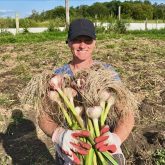More than 700,000 Canadians turn to food banks every month, and many of them are employed or from two-parent households
Food bank use is at near-record levels and will only come down if there’s an increase in affordable housing, says Food Banks Canada.
More than 700,000 Canadians turn to food banks every month because they have “to choose between paying rent or buying food,” said Katherine Schmidt, the organization’s executive director.
“At the root of the need is low income, whether in the short or long term,” she said. “Food bank use remains close to record levels and is 23 per cent higher than in 2008, before the recession began. During a time of apparent economic recovery, far too many Canadians still struggle to put food on the table.”
Read Also

Manitoba boosts stake in cereals centre to $23.5 million
Premier Wab Kinew said the additional project funds will help ‘Trump-proof’ the provincial economy.
The country has lost hundreds of thousands of high-paying manufacturing jobs over the last three decades, and their replacement tends to be low paid, part time and temporary. Moreover those who lack the skills required for better jobs have trouble accessing education and training programs, she said.
Tinkering with current social policy isn’t sufficient, and “real investment and new thinking” are required to combat the situation, she said.
“We lose billions of dollars each year trying to address the health and social consequences of poverty after it takes its toll rather than preventing it in the first place,” said Schmidt.
Food Banks Canada has identified five areas where the federal government could make a difference: affordable housing, more adult training, helping people find better-paying jobs, changing social security programs to encourage more self-sufficiency, and addressing “stunning levels of food insecurity in northern Canada.”
Food bank users defy popular stereotypes, Schmidt said. About 12 per cent are employed (another five per cent have been recently employed) and nearly half are two-parent families. Food banks typically give users about five days’ worth of food per month.














